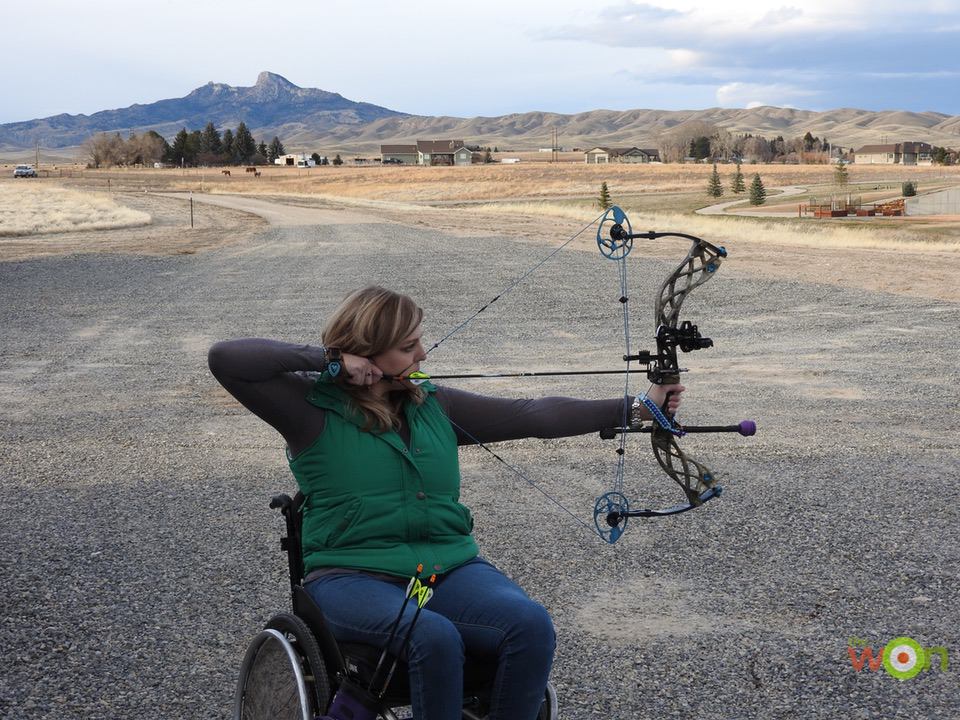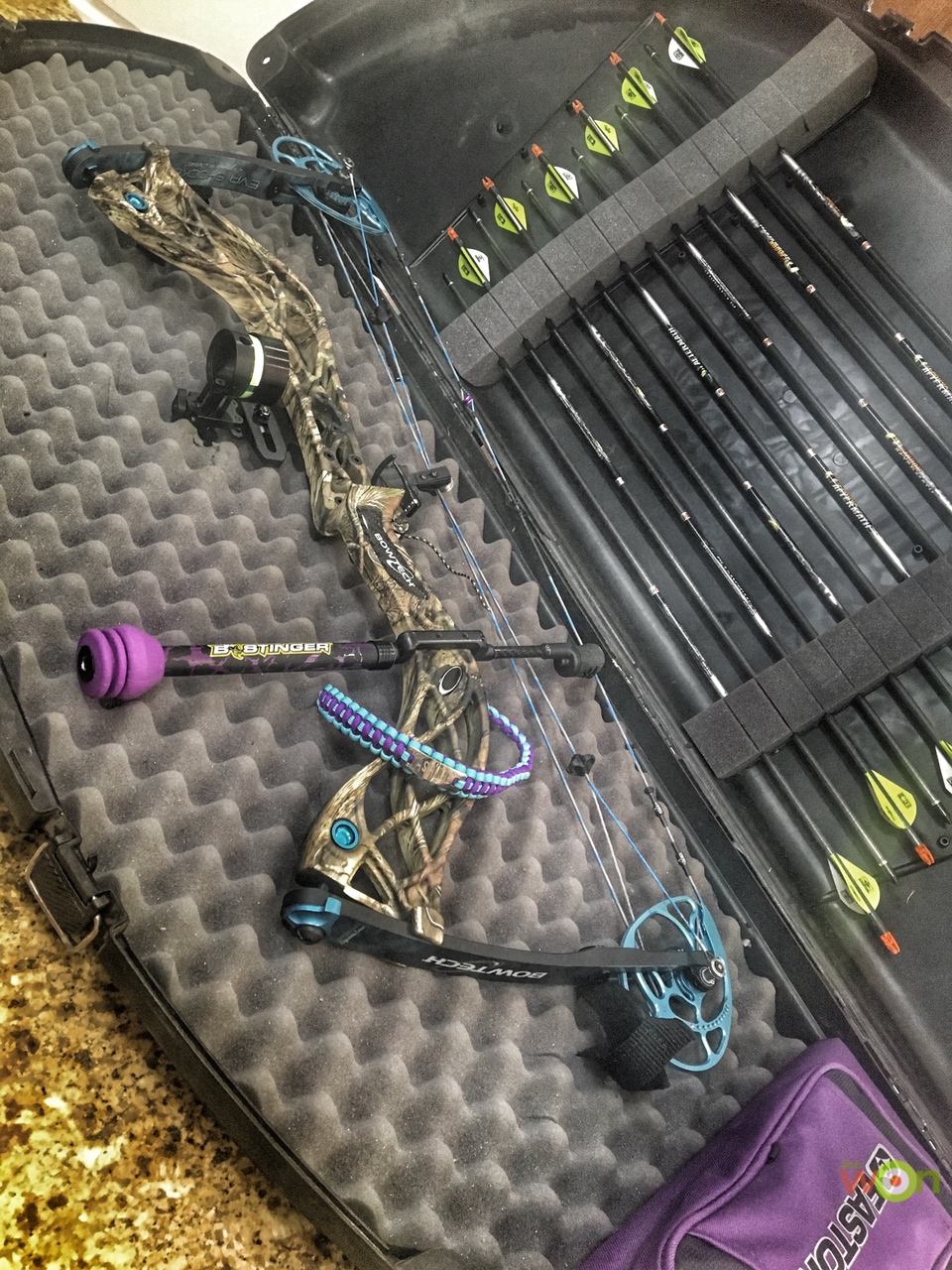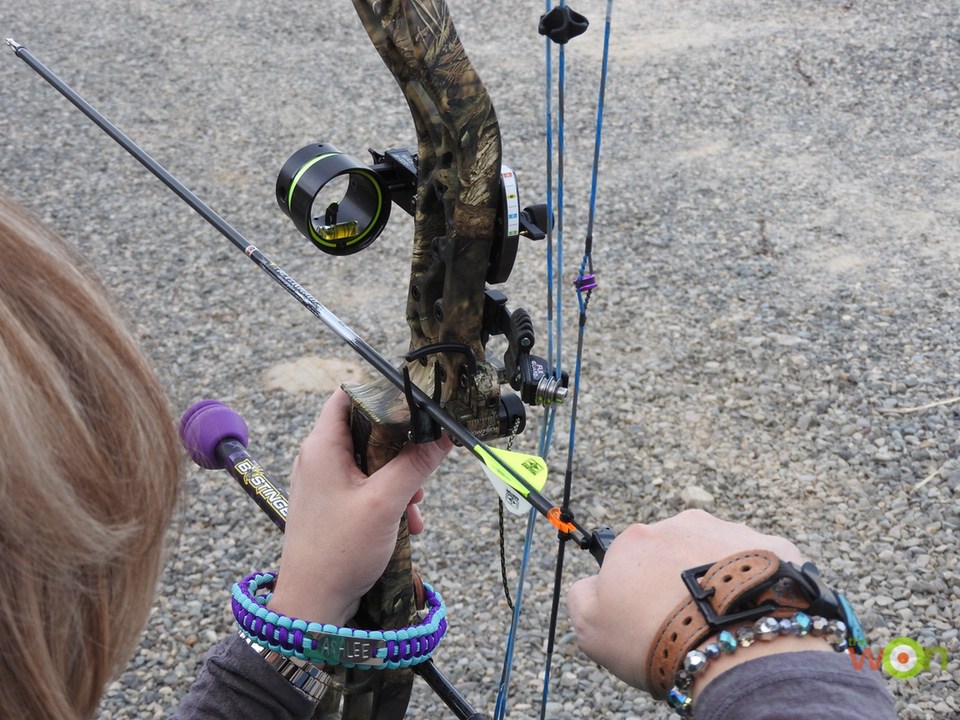When I initially started hunting, I used a crossbow. I had had a bad experience with a firearm, so the “point and shoot” option with no recoil on the crossbow appealed to me. I was successful harvesting mule deer my first 2 seasons before I branched out and re-attempted to hunt with a rifle and shotgun.
Redefining Life is sponsored by Mace Brand
I am constantly encouraging other people to get outside their comfort zones and try new things, so when someone asked me why I didn’t hunt with a compound bow, I found myself echoing the responses from others that I had previously challenged. “I just don’t know if I can pull one back.” “I don’t have the core strength or balance to shoot accurately.” “Compound bows are so complicated to set up.”
This summer, I headed 100 miles north to the Billings, Montana, Cabela’s to participate in the Shoot Like A Girl (SLAG) Coast To Coast Tour. My mom and daughter accompanied me, and to be honest, I really went to see my friends Karen Butler, Cristy Crawford and Jeanine Sayre from SLAG. Sure, I was interested in checking out their traveling bus with both gun simulator and archery range, but I had no idea the way this experience would change my hunting schedule.
After spending some time catching up with the ladies, we headed up the ramp and into the giant trailer. I shot a handgun and AR at the simulator and was turning to leave when one of the staff asked if I wanted to try shooting one of the compound bows. I saw a dozen bows hanging up on the wall and thought, “Why not?” This was an opportunity to try out several bows in a safe and friendly environment, so I swallowed my apprehension and admitted that I didn’t have a clue where to even begin in shooting a compound bow.

Shooting from the side of her wheelchair works well with for Ashlee’s balance issues.
When my accident happened in 1999, my spinal cord injury affected my stomach muscles and balance. I have great upper body strength from pushing my manual wheelchair, but between my paralysis and multiple abdominal surgeries, I have a very weak core. The only time I had ever attempted to shoot a compound bow, I nearly fell out of my chair, and when I did have maximum assistance to pull back the string, I ended up skinning my forearm and causing a massive bruise that took weeks to recede. No independence and an injury? No thanks.
With this experience in my head, I allowed the SLAG staffer to show me many different compound bows. After handling several, I was drawn to the Bowtech Eva Shockey Signature Series bow. Some of the bows seemed too delicate, but this bow felt significant in my hand while still being very lightweight. Just like the perfect handgun, it felt right in my hands. I learned about how the bow worked and what adjustments could be made to customize it to my long arms, and after showing me how to use the release, I was able to fire the bow with minimal assistance. And it was fun! This planted a seed in my head, and I knew that a compound bow was going to be a part of my future hunting plans.
Fast forward a few months, and I was given the opportunity to reach out to several archery companies to see about testing their equipment for this article. I have learned so much about compound bows and all of the accessories that go with them, as well as how to get the help you need to set them up and be successful in the field while hunting. This process can be very intimidating, so I hope my journey can encourage you to try something new as well!

Pulling back her bow now feels like second nature.
As I mentioned before, I liked the feel of the Bowtech Eva Shockey Signature Series bow. Not only was it lightweight and substantial, I appreciated that it was designed for women by a woman who had proven herself to be a serious archer. This wasn’t a bow where a company had taken a men’s bow, shrunk it down, slapped some pink camo on it and called it good for female hunters. Bowtech graciously agreed to ship me a bow in Mossy Oak Break-Up Country, but then they started asking questions to which I didn’t know the answer. What was my draw length? Which draw weight would I like? Yikes!
Fortunately, my husband is an archer, as are several of my close friends and family members. They could help me understand about customizing my bow to fit my body, including my long arms. There are several different ways to measure your draw length, and every time we measured, we came up with the same number – 28.5 inches. This is the top of the measurement on the adjustable bow, so we sent that info to Bowtech. I also knew that the minimum draw weight in Wyoming for deer and antelope is 40 pounds, but that I wanted to eventually hunt elk as well, which is a 50-pound minimum. With that in mind, I requested the 60-pound bow, knowing I could adjust it down as I started and crank it up as I progressed.

Ashlee loves how this bow turned out with all of the different accessories!
I had my bow ordered, and now I needed to focus on the accessories. This equipment field completely blew my mind! Not only are there a lot of pieces that you need to add to a compound bow, but also a massive variety of options for each piece. This is where knowing other archers and doing your research is paramount. Everyone is different and likes various set-ups, so there was a little trial and error, but for the most part, I was fortunate to get the right equipment on the first attempt.
I started with my sight. I liked the idea of having 1 point of reference to look at while adjusting outside of the sight for different yardages, very much like I would when using my rifle scope. With this in mind, and with the suggestion from a cousin, I went with the HHA Sports Optimizer Lite Single Pin adjustable sight. It was easy to install and sight in, and I like having the single pin to focus on when I am shooting. In the field, once I was settled in my blind, I ranged multiple distances from landmarks, and when a deer would come in, I would adjust my yardage before drawing. It functioned very well, and the company was amazing to work with. They even sent some additional products that my husband could put on his bow, and he was very happy with the results.
Next came the arrow rest. I knew I wanted a drop away rest and not a full capture rest. I had many friends who had issues with a full capture rest becoming damaged after multiple uses, and I wanted minimal contact with my arrows. As I do the majority of my hunting from my wheelchair on the ground, I knew I wouldn’t be able to hang upside down or from any other odd angle while shooting, so I wasn’t as concerned about the arrow being fully contained in the rest. After a lot of research, I ended requesting the QAD Bowtech Ultra Rest in Mossy Oak Break-Up Infinity. I like that it was specifically designed to complement the brand of bow I was using, and the reviews were outstanding. It was easy to install and operate, and I have had zero issues with it since it arrived.
Another accessory that I asked for based specifically on my bow was the Trufire Eva Shockey Signature Series release. I looked at several different types of releases, and once I knew that I wanted a hook style, it was an easy sell to get the release that matched the bow. I appreciate the durability of the leather strap, and now that I know how to put it on, I am getting more comfortable every time I use it. In the beginning, it was a little unwieldy, but that was completely operator error, as I had never used a release before. It’s becoming second nature now, and I feel more confident every time I strap it to my wrist.
Broadheads were an easy choice for me, as I shoot this brand with my crossbow and love the results I get. The company was very generous to set me up for my new compound bow, and I love the Rage Hypodermic 2 Blade 100 grain broadheads. These are sharp! The hypodermic tip is built for easy penetration and the stainless steel blades expand on contact, leaving a 2-inch entry wound. I also like that they send a practice head, in case adjustments need to be made between shooting field tips and your broadheads.
Finally, I needed a peep sight. I didn’t know what I was after, besides wanting something that was good quality and had great reviews. I thought it would be fun to add a little color to personalize my bow, so I actually started by looking for companies that offered color variety and went from there. I got lucky finding the RAD Super Deuce 38 in purple, and I liked the aluminum material and angle of the peep. My sight is round, and I knew I wanted the peep to line up correctly with that shape. I didn’t hurt that the company was incredibly helpful to work with in deciding what size aperture I needed (I went with 3/16” as the median option). RAD also produces a purple fixed blade broadhead, so they sent those along as well. With all of these amazing products and new relationships with wonderful companies, I was set. But how in the world to put it all together?

Ashlee earned a lot about how each of the bow accessories plays a part in becoming an accurate and consistent archer.
I have a friend that owns a gun shop here in Cody, so he is my go-to when it comes to purchasing firearms, but now I needed someone who specialized in archery equipment and had the tools necessary to assemble my bow. Thankfully, a lot of my family and friends recommended “The Bow Doctor,” Gary Shinn, a gentleman just outside of town who could help me in setting up my new bow with all of its accessories. We loaded up all the gear and headed out to his shop.
We spent the next few hours adjusting the bow and installing all the new accessories. I learned so much during this process – not only about how my bow worked, but also how all of the additional parts worked together to make me as accurate as possible. I worked on my posture and form as I operated the bow, and I was pleasantly surprised to discover I could pull back 45 pounds. I asked a lot of questions and tried different suggestions. Soon I was feeling more comfortable with the bow, but there were still adjustments that needed to be made before I could begin practicing shooting. Gary was heading out of town, but he recommended a bow shop in Billings as well as information regarding purchasing arrows, a wrist sling, a quiver and a bow stabilizer.
We took off for Superior Archery and met with the owner’s son, Tate Morgan. He set me up with some arrows and made some final adjustments on my bow, as well as offering some additional insights on my draw and the positioning of the bow in relation to my wheelchair. Archery is such a personal thing, and while there are certain rules that need to be followed for safety purposes, there are other aspects that work differently for each person.
Tate also showed me various quivers, and I decided right away that I didn’t want anything on my bow. I ended up going home and ordering an Easton Three Tube hip quiver in purple that attaches to the side of my wheelchair and holds the arrows in the perfect position for me to access them quickly and easily. He also recommended a Bee Stinger Pro Hunter Extreme stabilizer. The 6-inch model wouldn’t add a lot of weight to my bow, but it would balance it out and help with the string vibration.
My final purchase was my wrist sling. I knew right away I was going to contact Chelsea Cheff with SOS Gear in Montana. Chelsea has built an amazing paracord business, and she came make just about anything you can think of for your outdoor needs. I first met her when she made a turkey holder for my Action Track Chair, and it hasn’t left my chair since. She customized my wrist sling in purple and turquoise to match my bow set up, and she even added a name plate for extra personalization. It is one of my favorite parts about my bow!
The setup of my bow was quite a process, but in the end, I had a beautiful piece of hunting equipment that was perfect for me in every way. Now the big question; could I shoot it consistently and accurately? I had purchased a general deer tag, and while my season was open, I knew I needed to spend some time practicing with this new bow before I was ready to hit the field. My archery target was very used, so I reached out to Block Targets and they generously sent me their new 6×6 target, which I love. With 6 different sides to shoot into, and the fact that it can handle both field tips and broadheads, this quality target should last us for years to come. And it’s a good thing, because I certainly put it to work!

Ashlee’s first few arrows into the Block 6×6
Once my bow was sighted in, I shot arrow after arrow at varying yardages until it started to feel like second nature. With so many moving parts, I wanted to make sure that I not only felt comfortable shooting my bow, but also that I could adjust in the field and make adjustments in the heat of the moment if needed. Now, pulling back 45 pounds doesn’t even faze me, so once this deer season is over, my goal is to start turning up the poundage until I am comfortable shooting more than 50 pounds for elk season next year.
I now understand what all the fuss is about with shooting a compound bow. Set up is definitely not an easy process, but because it is so personal, you quickly become very invested to the experience. My husband used to go out and shoot his bow throughout the year for fun, and now we can do that together, like we do with our firearms. I also love that I took the challenge of something that I didn’t think I could physically do and adjusted it until it worked for me and my abilities. I am so thankful to the companies involved in this experience and their generosity and assistance. I hope this project will encourage you to get outside of your comfort zone and try something new – whatever it is!
Ashlee Lundvall writes a blog titled "Redefining Life," that follows her rise from a debilitating injury as a teenager to Ms. Wheelchair USA in 2013. Her first book, "A Redefined Life," was published in February of 2016, and she is on National Pro Staff for Mossy Oak and the NRA’s Disabled Shooting Sports committee. Ashlee is also the recipient of the 2017 SCI Foundation Pathfinder Award. Ashlee truly shines as a keynote speaker at outdoor industry and disability related events and conferences. She is passionate about mentoring newly injured patients, and loves to pass on her love for adapted outdoor recreation! View all posts by Ashlee Lundvall